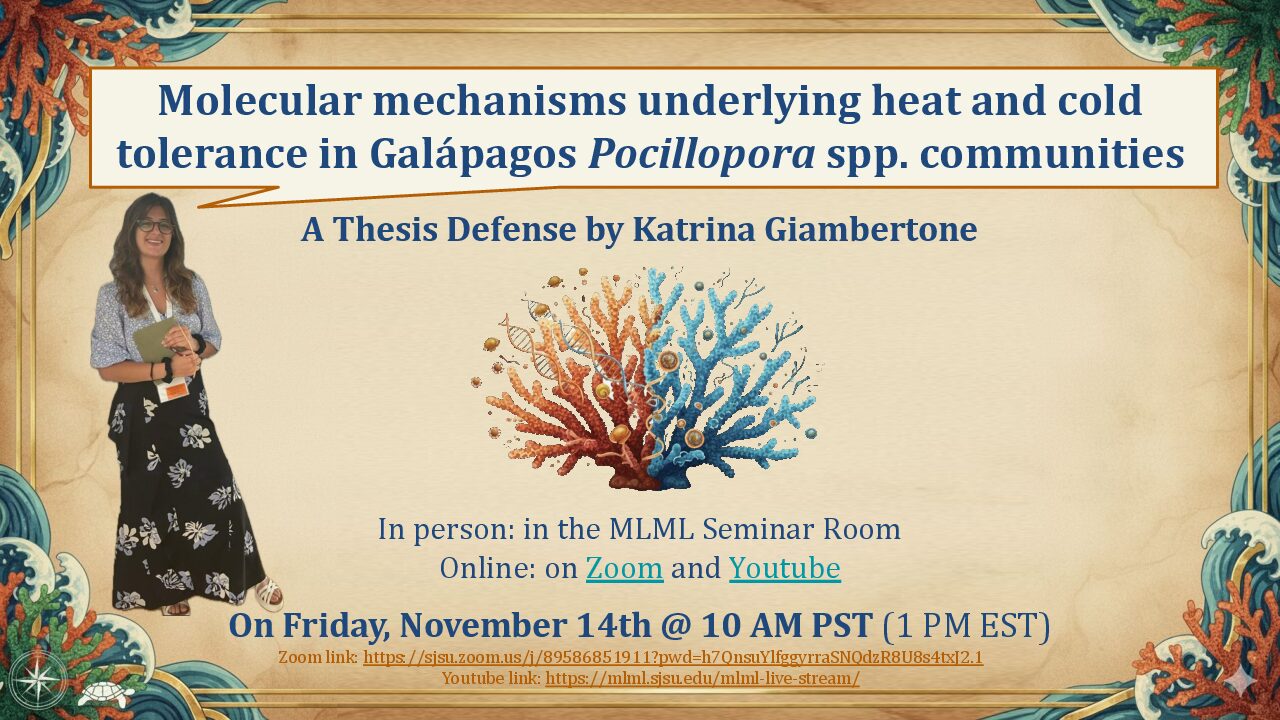Uncategorized
Application Assistance

Applications are open for the 2026 MLML Master’s Program in Marine Science!
Visit our How to Apply page to learn how to apply.
Also see our Application Timeline for a step by step visual!
To provide assistance with the application process, MLML hosts two events:
Zoom Drop-in with the Grad Coordinator - 11:00 am PST on November 14th
Register and join the zoom here: https://sjsu.zoom.us/meeting/
Zoom Drop-in Office Hours with Faculty - 1:00 pm PST on December 1st
Register and join the zoom here: https://sjsu.zoom.us/meeting/
Crowfunding Page – NOW LIVE
Our Page is Live!
Please consider helping the students at Moss Landing Marine Labs by donating here: MLML Day of Giving Page. The funds will go towards supporting student scholarships and activities. Your contribution, no matter the size, will positively impact a student at MLML.
Our Crowdfunding campaign is running until April 27th!

MLML Open House Auction Page is now LIVE!
Last weekend, Moss Landing had our first in-person open house in 4 years! The event was a huge success, including the kickoff for our online silent auction! The auction will run until April 29th, 9:00pm, where you can bid on a variety of item that local artists, business-owners, and organizations have donated to sold to the highest bidder! All money raised will go towards providing next year's financial aid and scholarships for our students. This will directly benefit the members of the MLML community by raising awareness of marine science while providing funding to graduate students. Items include golf and lunch for 2 at Carmel Ranch, a print by local biological illustrator Amadeo Bachar, a Folktale Winery Tasting and bottle of wine, and much more! If you're interested in any of these items and the current bids, you can check out the ongoing auction here!

Open House – April 22nd Schedule
Open House Schedule
As Open House approaches, we at MLML have finished scheduling our activities and events for the day. Lab-run events such as our touch tank, microscopy room, and miniature ROV tank will be available all day from 9am to 5pm. Merchandise will also be available all day, although we may run out of some items earlier in the day. Our speed talks and trivia sessions given by faculty and students will be on a scheduled basis that you can attend at your convenience. To see where our activities are located, please see the map below.
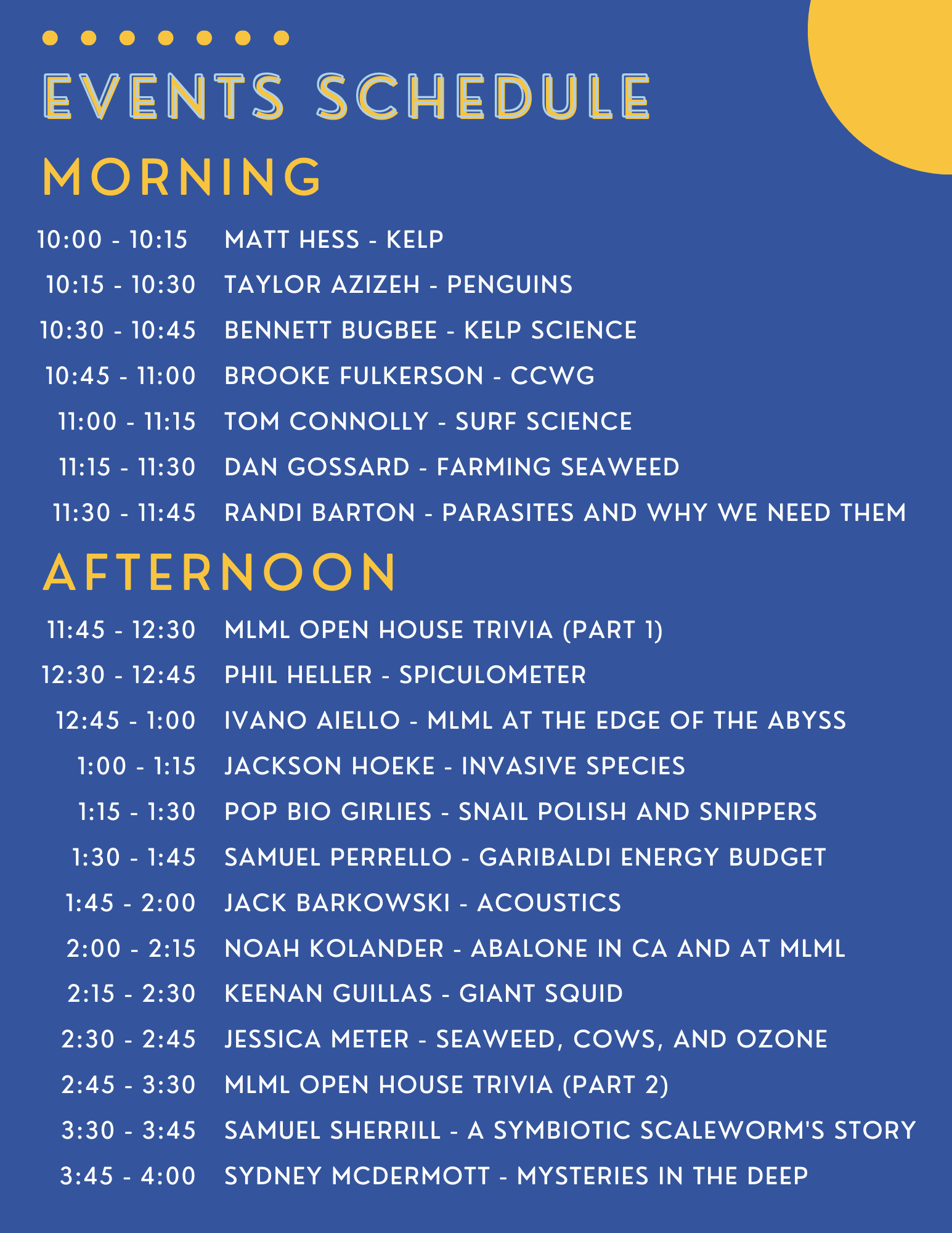

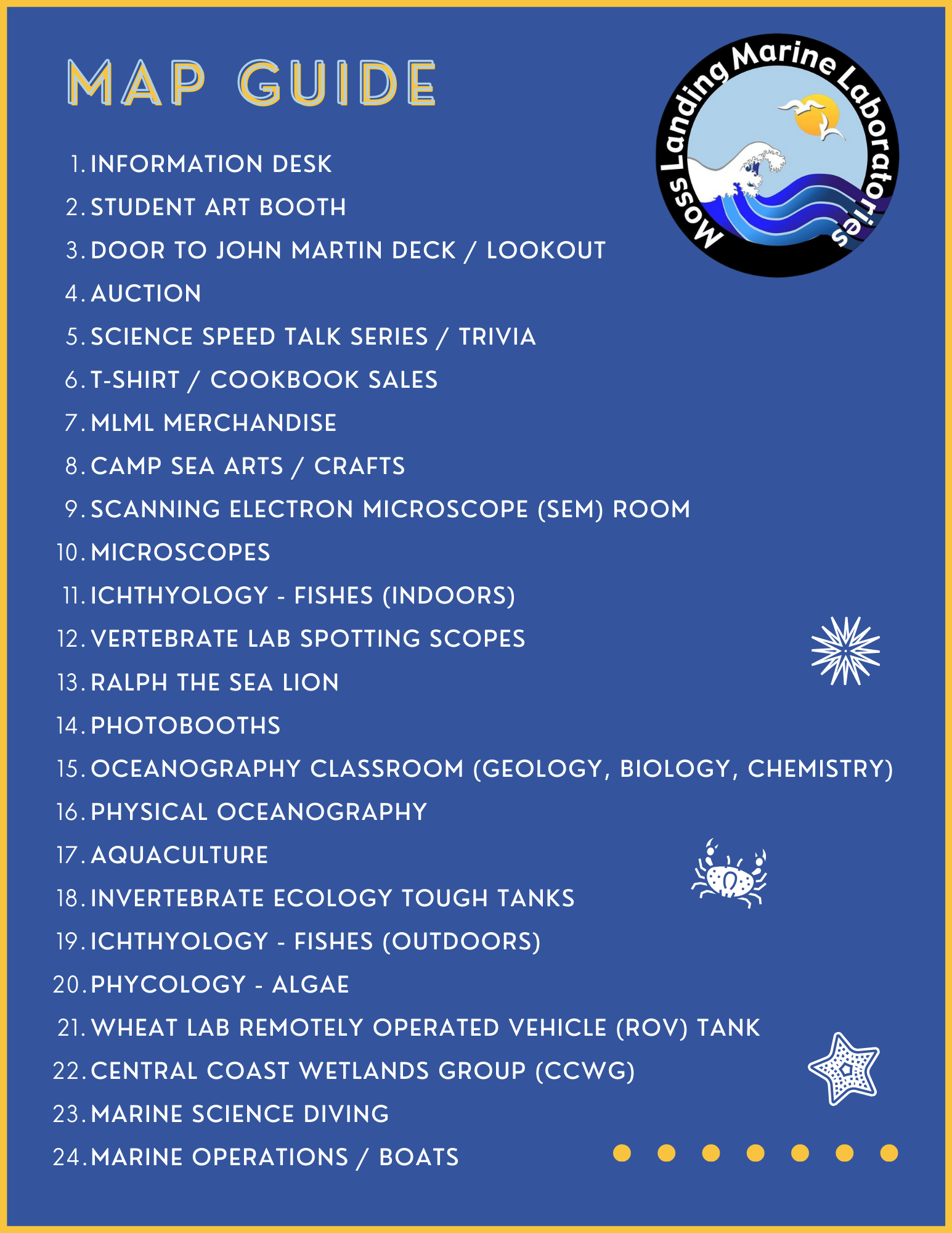
MLML’s 2023 Open House Crowdfunding Page is now LIVE!

In conjunction with our in-person open house event this year, Moss Landing is opening our crowdfunding page! Our goal is to raise $20,000 to support student scholarships, marine research equipment, and funding to cover student research expenses. If you cannot make it to our open house event this year, donating is an excellent way to help support MLML students. We will be sending a special thank you to everyone who donates on our social media platforms at the end of the crowdfunding event. If you're interested in donating, you can find the crowdfunding page here. If you'd like to attend our in-person open house from 9:00am - 5:00pm on April 22nd, you can RSVP through the following form.
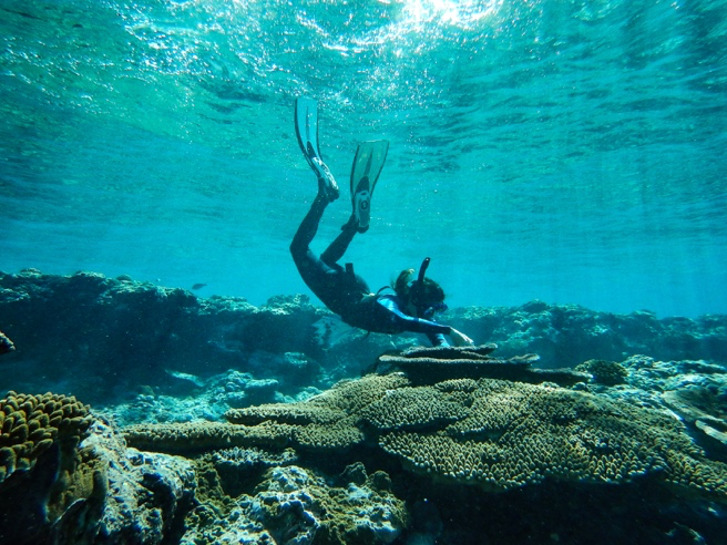
MLML Executive Director
Employment Opportunity: MLML Executive Director
San Jose State University’s Moss Landing Marine Laboratories has an outstanding leadership opportunity for an Executive Director. Moss Landing Marine Labs (MLML) is a unique marine research and education program within the College of Science at San Jose State University (SJSU). Faculty and researchers have expertise in a range of marine science disciplines, including marine geology, biology and chemistry. The laboratory is located between Santa Cruz and Monterey, and borders the Monterey Bay Marine Canyon,
the Salinas River, and the Elkhorn Slough, making it an ideal location for modern marine science.
This leadership role is responsible for administrative oversight of operations, budgets, fiscal management, leadership of staff, philanthropic activities and collaboration with the College of Science on strategic planning. The role reports to the Dean of the College of Science at SJSU, and collaborates with the Chair of the MLML academic department.
Key Responsibilities
- Management oversight for MLML staff.
- Recommends initiatives and changes to maintain quality and fiscal responsibility of services at MLML. Develops and presents recommendations for improvement of established processes and practices to the college Dean; initiates and implements plans to solve problems with the college Dean’s approval.
- Manages the physical facilities (properties, buildings, piers and
ships) and oversees maintenance and development of facilities in a manner consistent with fiscal resources and SJSU strategic
objectives. - Ensures contractual, fiscal, and accounting practices are followed in accordance with applicable federal, state, SJSU and California State University rules and regulations.
- Oversees faculty affiliates and researchers, and fosters
partnerships, while ensuring fiscal responsibility with respect to MLML SJSU state and Research Foundation properties and facilities. - Obtains outside funding in support of MLML in collaboration with the College of Science.
Key Competencies
Expert in Marine Sciences. Excellent communicator and strong leader to build and manage a diverse team. Experience managing complex budgets, strategic goals and balancing day to day operations. Ability to operate in a unionized environment. Excellent collaborator, innovator. Ability to influence and lead the organization into the future.
Requirements Include
- Doctorate in one of the disciplines in the field of marine science.
- A strong record of scholarly work or professional achievement rooted in conducting field-oriented marine studies balanced with laboratory work and quality teaching sufficient to qualify for tenure and appointment at the rank of professor in the college.
- Three years of administrative experience as department chair, program coordinator, or other relevant leadership and supervisory experience.
- Extensive experience managing complex
budgets. - Proven track record in securing external
funding. - Direct experience managing a team.
For Consideration, please email your CV/resume to Elaine Peters at elaine@nextsearch.com 949-400-1132
Happy Holidays from MLML!
Moss Landing celebrated a fantastic year with the first annual Christmas party since the beginning of the pandemic. A festive time was had by all, and as the holidays approach MLML would like to extend an enthusiastic "Merry Christmas and Happy Holidays"! See you next year!
Photo credits go to our wonderful student body president, Taylor Azizeh.
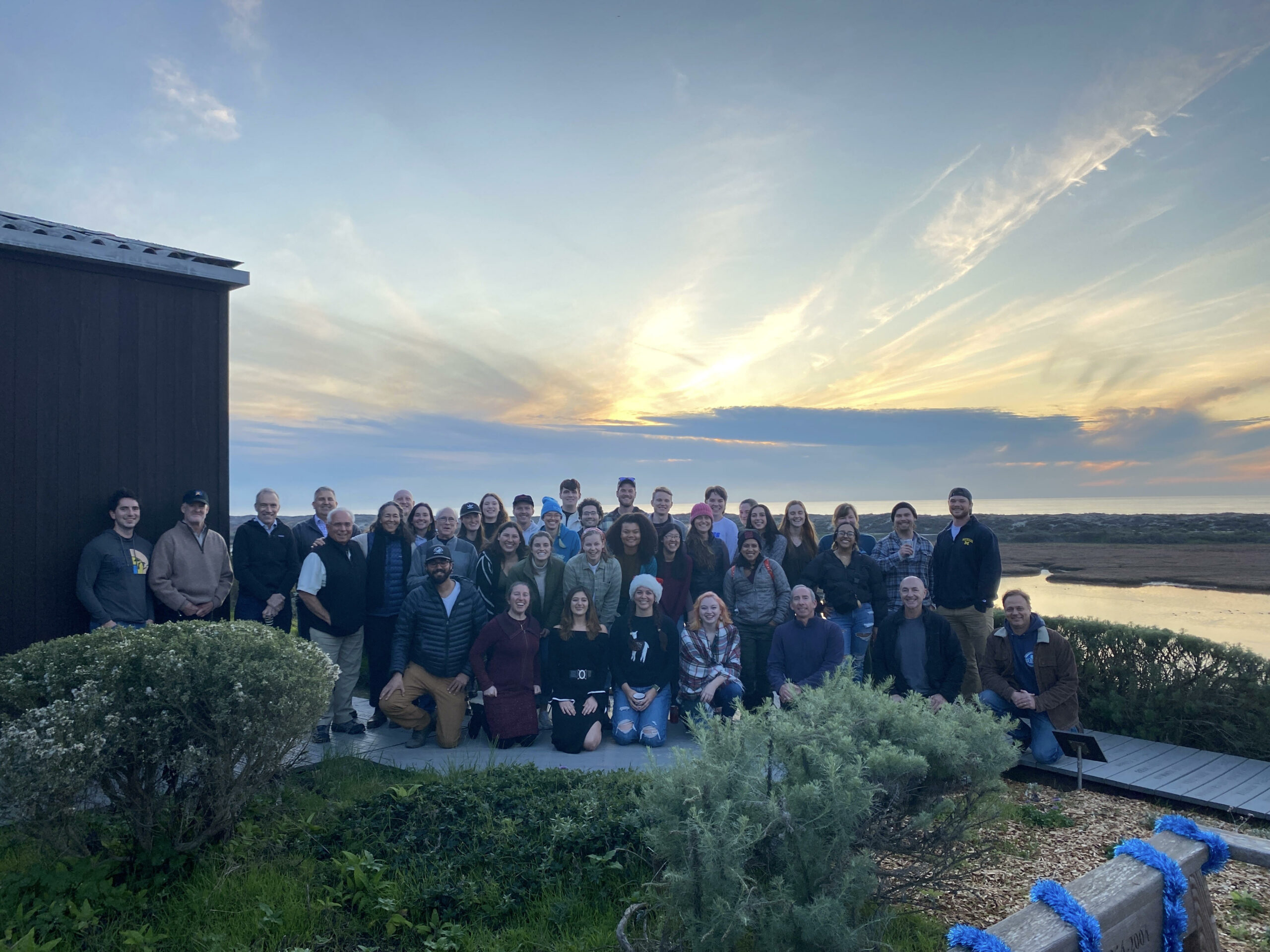
Virtual Seminar – The influence of oceanographic and environmental features on plankton and seabird communities in the North Pacific- March 10th
Caitie Kroeger, Moss Landing Marine Laboratories/Farallon Institute
Hosted by the Vertebrate Ecology Lab
Presenting: "The influence of oceanographic and environmental features on plankton and seabird communities in the North Pacific"
MLML Virtual Seminar | March 10th, 2022 at 4pm
Caitie’s research is centered on understanding the direct and indirect effects of oceanic and climatological forcing on the energy balance, movement patterns, and distributions of marine organisms. She earned her Ph.D. in Ocean Science from the University of California Santa Cruz, where she studied the ecophysiology of sub-Antarctic albatrosses and co-founded a science communication group. She then joined the Farallon Institute as a postdoctoral researcher, where she explored the effects of marine mesoscale eddies on structuring plankton and seabird communities and used spatial-temporal models to map seabird distributions for oil-spill risk assessment. She recently joined MLML as a postdoctoral researcher in the Vertebrate Ecology Lab where she’s investigating the foraging ecology and habitat use of emperor penguins.
Ichthyology Lab alumnus Evan Mattiasen publishes results of thesis research on rockfish behavior and physiology
MLML alumnus Evan Mattiasen recently published the results of his thesis research in the journal Global Change Biology!
This study, co-authored by SJSU/MLML Ichthyology Lab professor Dr. Scott Hamilton and CSUMB professor Dr. Cheryl Logan, examines the effects of low oxygen conditions (hypoxia) on rockfish behavior and physiology. The results of this study are particularly relevant for fish stock management in light of global climate change, which is predicted to increase the frequency and severity of hypoxia.
Read Evan’s paper, titled "Effects of hypoxia on the behavior and physiology of kelp forest fishes", here: https://onlinelibrary.wiley.com/doi/abs/10.1111/gcb.15076



